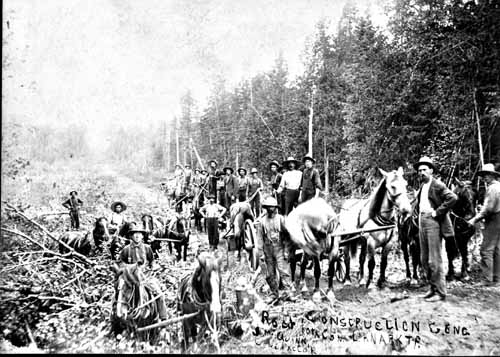This is the “Toll Gate House” located just south of the Village of Lanark on Hwy # 511.
Every thirty miles, years ago, tolls were situated along on the Eastern Townships Autoroute in Quebec, and people complained about having to pay for the maintenance of the roads. Imagine if they had to endure the roads in the 1800’s. If you used a road, you had to stop and pay a toll, and this money was used to maintain them. There were many Toll Gates in Eastern Ontario. Farmers used to have to maintain the roads that were adjacent to their property, by crushing stones and grading the roadway. If you didn’t do this, there could be fines imposed.
Roads, for longer than people could remember, were nothing more than dirt tracks that turned to mud in the winter and baked rock hard in the summer. Either way, movement along these ‘roads’ was difficult and at certain times of the year, practically impossible especially in Montague Township where farmers suffered due to bad road conditions. So the toll was a way to supposedly get better roads.
The public was given the opportunity to invest in these road companies. The money raised by charging people to use the roads was split between profits for the share holders and the cost of maintaining the roads in the control of the trust.Toll gates were established through which people and carriages had to pass before continuing with their journey. People began to object paying a toll. Some would even jump over the toll gate to avoid paying. To decrease the chance of this happening, spikes (or pikes) were put at the top of the gates – hence the title turnpike trusts. In some parts of the country, the toll gates were so unpopular, that they were destroyed
The 1855 Municipal Manual for Upper Canada granted private road companies the right to collect tolls in consideration of planking, graveling, or making a bridge. The public was given the opportunity to invest in these companies. Any group of men with a minimum of 5 people could form a joint stock company as long as they built a minimum of two miles of road. There could be a toll gate every five miles, and the charge was a penny per mile with a half penny extra for animals. Most of the roads were laid with pine blanks most of it from the John Gillies sawmill.
Even the Lanark Era newspaper got into the fray, and advertised where the secret non paying roads were- which didn’t make sense. But if you went to church, or were a man of uniform, you could forgo all means of payment . By 1856 people had enough and refused to pay because the planks were rotting away. Word up and down the Lanark line was that the roads were so bad even the transportation of corpses couldn’t make it to their destinations. In1904 tolls ceased to exist as the maintenance of the road was taken over by the county.
Photo of Lanark County Road Crew from Bytown or Bust
Last Photo of Carleton Place from the Carleton Place and Beckwith Heritage Museum




toll gate house id be interested in knowing the exact address for this as my parents home that resides on Hwy 511 at one time there was a toll gate there and weve been told that it use to have a salloon on the property where the house sits now i beleive it was lot concession 5 Drummond township
LikeLike
karen… I will try and find out… but if you hear anything.. let me know.
LikeLike
lot 6 concession 5 im not overly brilliant when it comes to North,South, West and East but the corner is now known as Armstrongs corners towards Perth from Balderson
LikeLike
Okay I am going to look for it.
LikeLike
Reblogged this on lindaseccaspina.
LikeLike